Innovations in Musical Instruments
With globalisation, Indian artforms are more widespread. Larger auditoriums, extensive travel and many more concerts have inspired rethinks on the construction of many traditional instruments. Restrictive luggage constraints made portability key. Long tours without access to repair technicians necessitated durability. Such practical needs coupled with a desire for a unique footprint in a small, extremely competitive space has resulted in several innovations in the musical instruments used in Indian music, with variable levels of adoption.
This article is part of the Kalpalata Fellowship for Classical Music Writing 2023. It appeared in The Hindu newspaper dated August 4th, 2023.
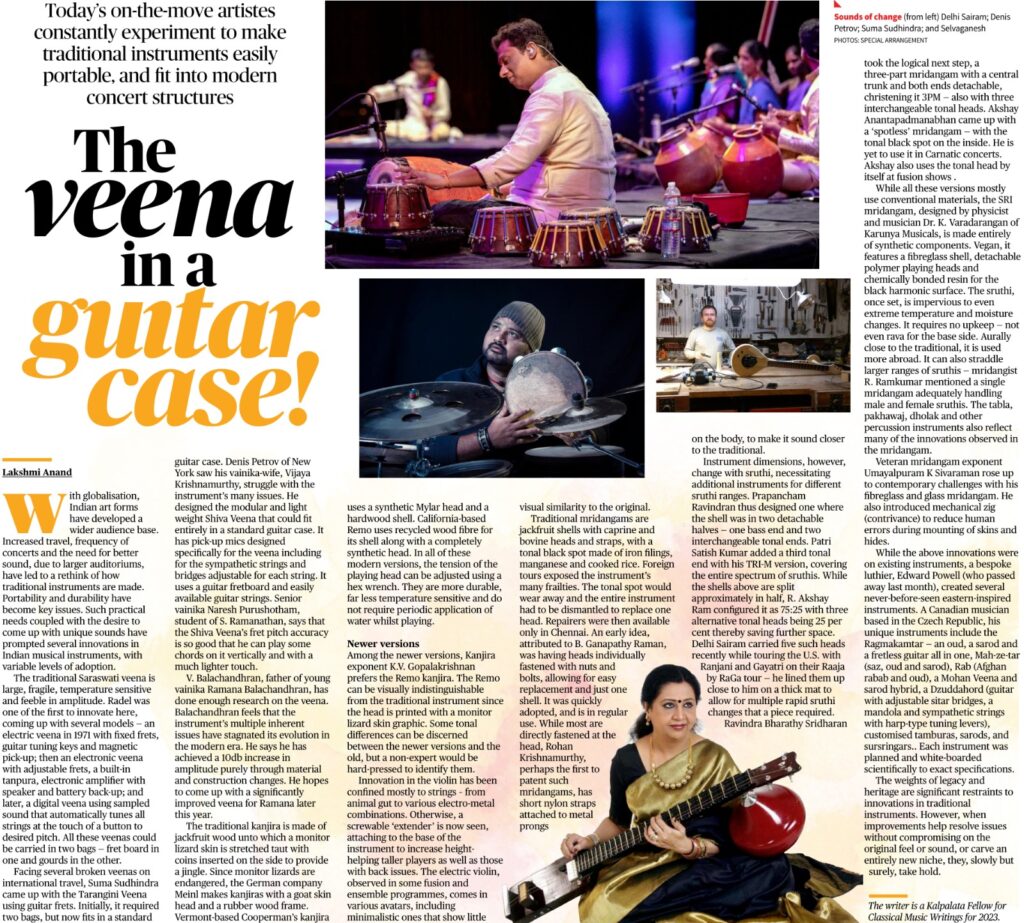
The traditional Saraswati veena is large, bulky, fragile, non-modular, temperature sensitive and feeble in amplitude. Radel was one of the first to innovate here, coming up with several models – an electric veena in 1971 with fixed frets, guitar tuning keys and magnetic pick-up; then an electronic veena with adjustable frets, a built-in tanpura, electronic amplifier with speaker and battery back-up; and later, a digital veena using sampled sound that automatically tunes all strings at the touch of a button to desired pitch. All these veenas could be carried in two bags – fret board in one and gourds in the other.
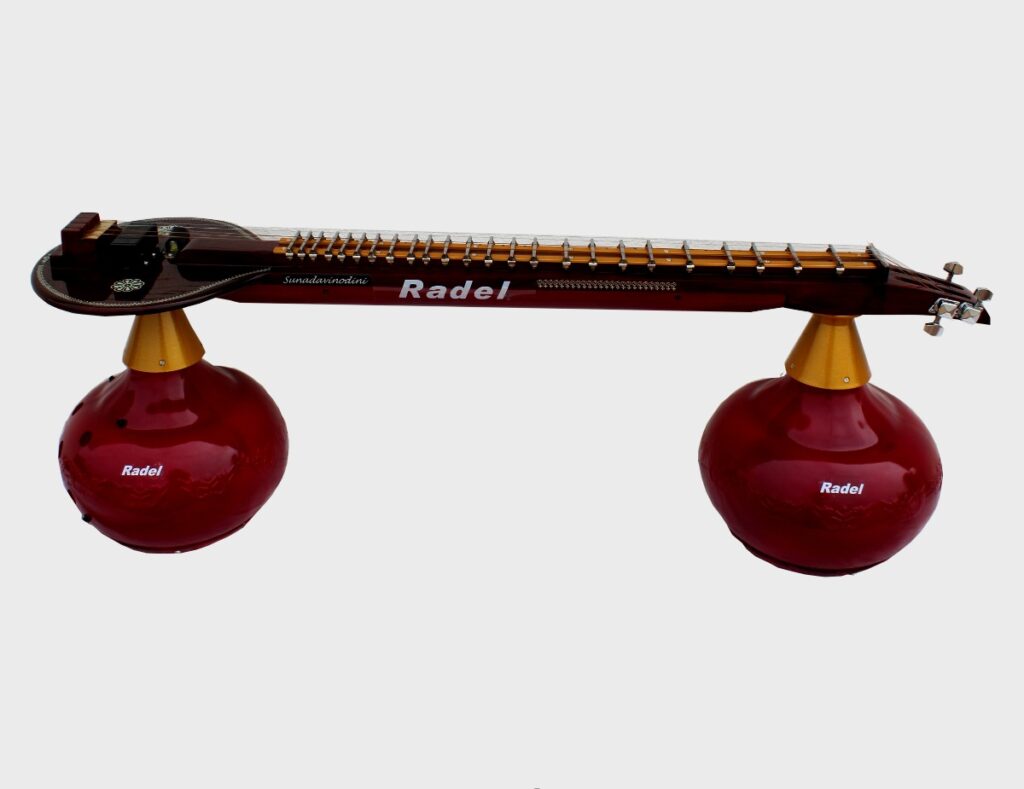
Facing several broken veenas on international travel, Suma Sudhindra arrived at a hardier, more weather resistant and compact design with her Tarangini Veena using guitar frets. Initially requiring two bags, it now fits in a standard guitar case. The cost is comparable to a good quality traditional veena.
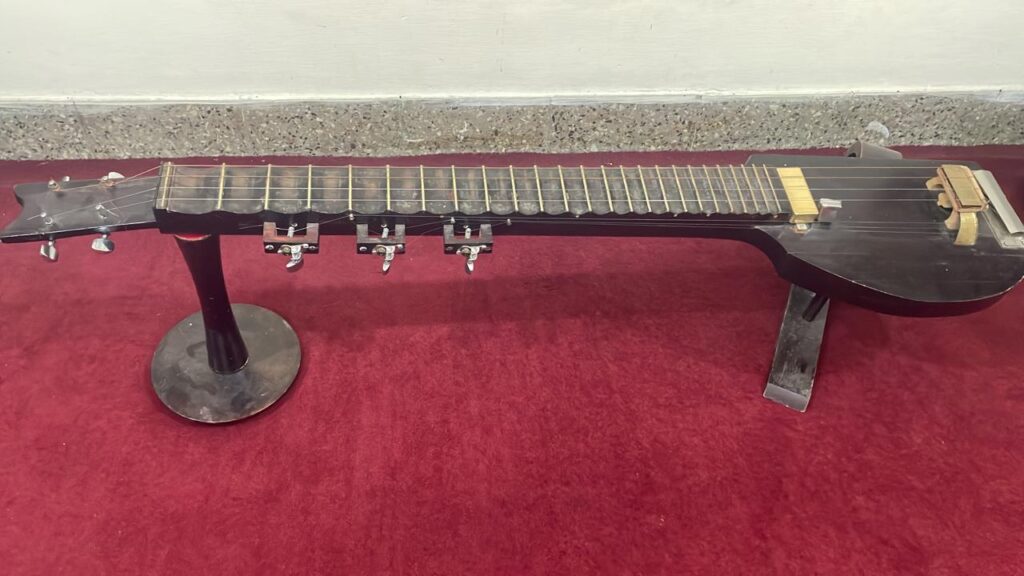
Photo courtesy: Smt. Suma Sudhindra.
Denis Petrov of New York saw his vainika wife, Vijaya Krishnamurthy, struggle with the instrument’s many issues. He designed the Shiva Veena to be modular and light weight and fit entirely in a standard guitar case. It has pick-up mics designed specifically for the veena including for the sympathetic strings, with bridges adjustable for each string. It uses a guitar fretboard and easily available guitar strings. Senior vainika Naresh Purushotham, student of Dr. S. Ramanathan, says that string changes are a breeze and the Shiva Veena’s fret pitch accuracy is so good that he can play some chords on it vertically and with a much lighter touch. Made entirely in the USA, the Shiva Veena is expensive. However, Denis is exploring a significant reduction soon in selling price.
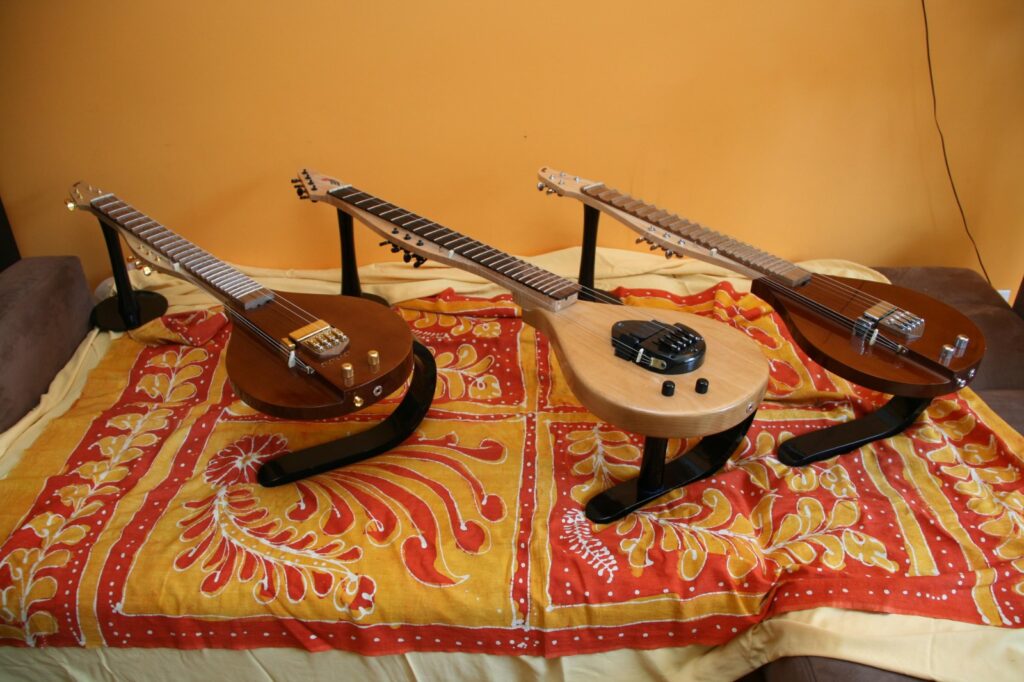
Photo courtesy: Smt. Vijaya Krishnamurthy.
V. Balachandhran, father of young vainika Ramana Balachandhran, believes the instrument’s multiple inherent issues have stagnated its evolution in the modern era. He has spent several years doing empirical research on the veena. Using carpenters, welders and other trade specialists, he has tried innumerable permutations and combinations of old and new materials for every part of the veena, from tiny to large. He says he has achieved a 10db increase in amplitude purely through material and construction changes. His hope is to come up with a significantly improved veena (with no obvious change in appearance) for Ramana later this year. Highly dependent on artisan availability and actual results, he keeps his fingers crossed.
The traditional kanjira is made of jackfruit wood unto which a monitor lizard skin is stretched taut with coins inserted on the side to provide a jingle. Its compact size and relative simplicity makes it a popular addition to world music ensembles outside of the Indian diaspora as well. Since monitor lizards are endangered, new kanjiras cannot legally be made with their skin. The German company Meinl makes a kanjira with a goat skin head and a rubber wood frame. Vermont based Cooperman’s kanjira uses a synthetic Mylar head and a hardwood shell. California based Remo uses recycled wood fibre for its shell along with a completely synthetic head. In all of these modern versions, the tension of the playing head can be adjusted using a hex wrench. They are more durable, far less temperature sensitive and do not require periodic application of water whilst playing.
Kanjira exponent KV Gopalakrishnan, also well versed with newer versions, prefers the Remo amongst the above. Having used it at Carnatic fusion concerts, he rates it “100 for looks, 90 for sound and 80 for feel” compared to the original. The Remo can be visually indistinguishable from the traditional instrument since the head is printed with a monitor lizard skin graphic. Side by side with the traditional one, some tonal differences can be discerned, but a non-expert would be hard pressed to distinguish them.
Innovation in the violin has been confined mostly to strings – from animal gut to various electro-metal combinations. Otherwise, a screwable ‘extender’ is now seen, attaching to the base of the instrument to increase height- helping taller players as well as those with back issues. The electric violin, observed in some fusion and ensemble programs, comes in various avatars, including minimalistic ones that show little visual similarity to the original.
Traditional mridangams are jackfruit shells with caprine and bovine heads and straps, with a tonal black spot made of iron filings, manganese and cooked rice. Foreign tours exposed the instrument’s many frailties. The tonal spot would wear away and the entire instrument had to be dismantled to replace one head. Repairers were then available only in Chennai. An early idea, attributed to B. Ganapathy Raman, was having heads individually fastened with nuts and bolts, allowing for easy replacement and just one shell. It was quickly implemented by others and is in regular use. While most are directly fastened at the head, Rohan Krishnamurthy, perhaps the first to patent this type of mridangam, attached short nylon straps to metal prongs on the body, allowing for no change in feel from the traditional.
Instrument dimensions, however, change with sruti, necessitating additional instruments for different sruti ranges. Late Prapancham Ravindran designed one where the shell was in two detachable halves – a single bass end and with two interchangeable tonal ends. Patri Satish Kumar added a third tonal end with his TRI-M version, covering the entire spectrum of srutis. While the shells above are split approximately in half, R. Akshay Ram configured it as ~75:25 with three alternative tonal heads being 25%, thereby saving further space. Delhi Sairam carried five such heads recently while touring the USA with Ranjani Gayatri on their Raaja by RaGa tour – he lined them up close to him on a thick mat to allow for multiple rapid sruti changes that a presented piece required.
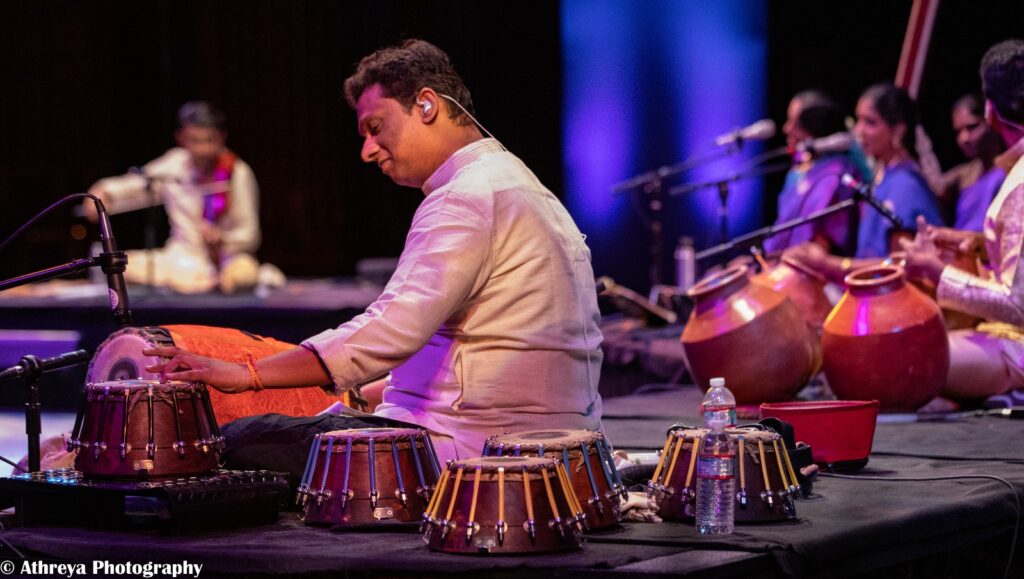
Photo courtesy: Delhi Sri. Sairam.
Ravindra Bharathy Sridharan took the logical next step, a 3 part mridangam with a central trunk and both ends detachable, christening it 3PM –- also with three interchangeable tonal heads. Akshay Anantapadmanabhan came up with a ‘spotless’ mridangam – with the tonal black spot on the inside. He is yet to use it in Carnatic concerts. He also uses the tonal head by itself at fusion shows.
While all these versions use mostly conventional materials, the SRI mridangam, designed by physicist and musician Dr. K. Varadarangan of Karunya Musicals, is made with all synthetic materials. Vegan, it features a fibreglass shell, detachable polymer playing heads and chemically bonded resin for the black harmonic surface. The sruti, once set, is impervious to even extreme temperature and moisture changes. It requires no upkeep – not even rava for the base side. Aurally close to the traditional, it is used more abroad than in India. It can straddle larger ranges of srutis too – mridangist R. Ramkumar mentioned a single mridangam adequately handling male and female srutis. The tabla, pakhawaj, dholak and other percussion instruments also reflect many of the innovations observed in the mridangam.
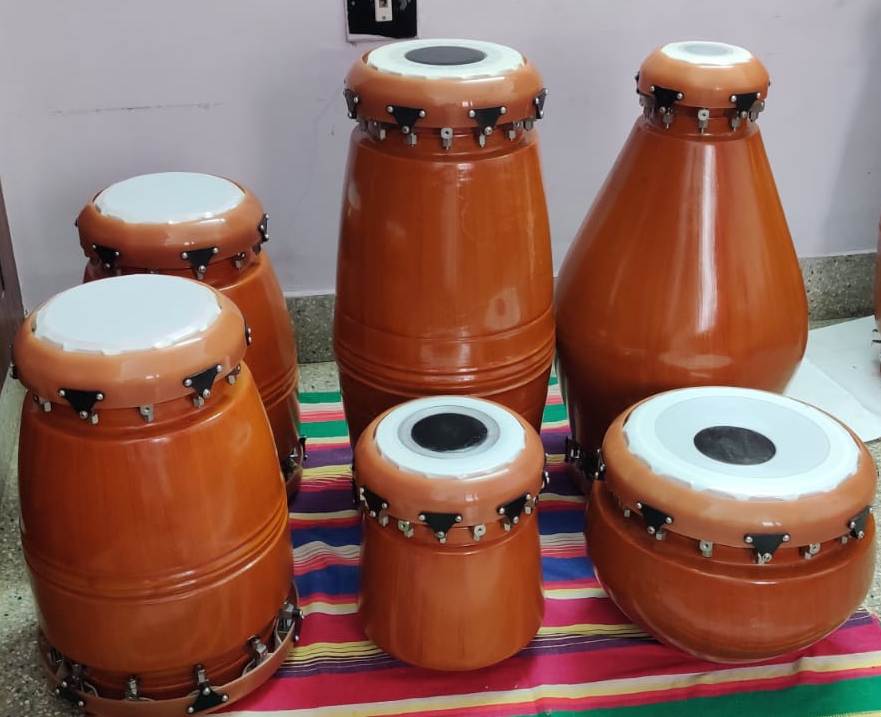
Photo courtesy: Dr. K. Varadarangan.

While the above innovations were on existing instruments, a bespoke luthier, Edward Powell (who passed away last month), created several never-before-seen eastern-inspired instruments. A Canadian musician most recently based in the Czech Republic, his unique instruments arose from being a multi-instrumentalist desiring to carry only one instrument sans a car. Originality and avoiding comparison with native practitioners were key goals too. This resulted in the Ragmakamtar – an oud, a sarod and a fretless guitar all in one. His one-of-a-kind constructions soon caught the eye of world-wide musicians who requested him to build their own singular combo instruments. He subsequently made a Mah-ze-tar (Saz, Oud and Sarod), Rab (Afghan Rabab and Oud), a Mohan Veena and Sarod hybrid, a Dzuddahord (Guitar with adjustable sitar bridges, a mandola and sympathetic strings with harp-type tuning levers), custom tamburas, sarods, sursringars and more. Each instrument was planned and white-boarded scientifically to the customer’s exact specifications.
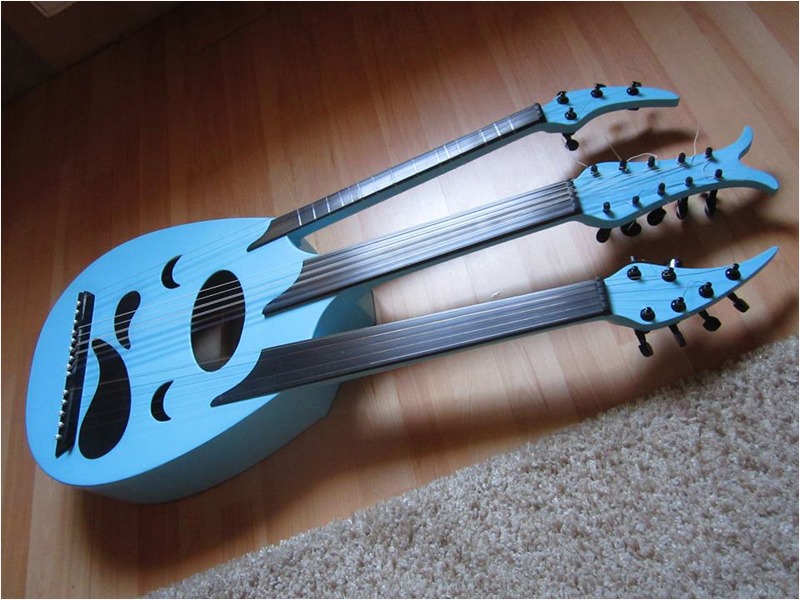
Photo courtesy: Edward Powell.
The weights of legacy and heritage are significant restraints to innovations in traditional instruments. Thus, while often observed with interest, they take significant time to steep and get accepted. However, when improvements either resolve real issues at a reasonable price point without compromising feel, sound or appearance, or carve an entirely new niche, they, slowly but surely, take hold.
This article could not have happened without many individuals freely giving of their time and energies and I am most grateful to every one of them. These include Sarvasri. Naresh Purushotham, R. Ramkumar, Akshay Anantapadmanabhan, Smt. Radhika Raj Narayan, Sarvasri. V. Balachandhran, K.V. Gopalakrishnan, Smt. Vijaya Krishnamurthy, Dr. K. Varadarangan, Sarvasri. L. Ramakrishnan, Delhi Sairam, G. Guru Prasanna, Arijit Mahalanabis and Smt. Suma Sudhindra. I remember the late Edward Powell with sadness…. When I reached out to him a few months ago, he said he could talk for only a few minutes at a time. It was in a later conversation that he mentioned he was ailing. Yet, when he died on July 15th, 2023, it was a shock. He will be missed.
Related Links: